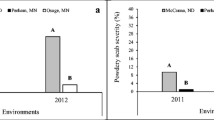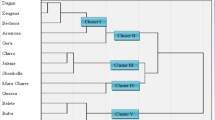Abstract
Silver scurf, caused byHelminthosporium solani, is an important disease of table stock and processing potatoes, for which few management strategies exist. Two hundred-twelve accessions of tuber-bearingSolarium species were screened for their response toH. solani. Tubers were inoculated in the laboratory with a spore suspension, incubated for 1 mo, and evaluated for infection using the number of conidiophore groups per square millimeter of sporulating tuber surface. Tubers with relatively low sporulation in the laboratory were retested using natural inoculum present in potato storages and assessed for infection. There were significant differences (P < 0.05) between accessions with both methods of inoculation. Some accessions ofSolanum demissum, S. chacoense, S. acaule, S. stoloniferum, S. oxycarpum, andS. hondelmannii consistently demonstrated low sporulation in laboratory and storage, suggesting partial resistance. Both methods of inoculation, laboratory and storage, were found to be correlated (ranging from r = 0.582,P= 0.006; to r = 0.925,P < 0.003).
Compendio
La costra plateada de la papa, producida por Helminthosporium solani, es una enfermedad importante en papas para consumo fresco y procesamiento, con limitadas prácticas de manejo. Se evaluaron 212 entradas de Solanum tuberíferos por su respuesta a H. solani. Los tubérculos fueron inoculados en laboratorio con una suspensión de esporas, incubados por 1 mes, y evaluados por infección usando el numéro de grupos de conidióforos por milímetro cuadrado de superficie de tubérculo con esporulación. Los tubérculos con baja esporulación en el laboratorio fueron re-evaluados usando inóculo natural presente en almacenes de papa y analizados por infecciín. Se encontraron diferencias significativas (P<0.05) entre las entradas con los dos metodos de inoculación. Algunas entradas de S. demissum, S. chacoense, S. acaule, S. stoloniferum, S. oxycarpum, y S. hondelmannii mostraron consistentemente reducida esporulación en laboratorio y en almacen, lo cual sugiere una resistencia parcial. Se encontró que ambos metodos de inoculación, laboratorio y almacen, estaban correlacionados (rango de r = 0.582, P= 0.006; ar = 0.925, < 0.003).
Similar content being viewed by others
Literature Cited
Adams, M.J., P.J. Read, D.H. Lapwood, G.R. Cayley and G.A. Hide. 1987. The effect of irrigation on powdery scab and other tuber diseases of potatoes. Ann Appl Biol 110:287–294.
Brown, C.R. 1990. Modern evolution of the cultivated potato gene pool. Pages 1–11In: The Molecular and Cellular Biology of the Potato. Biotechnology in Agriculture No.
Michael Vayda and William Park, eds. C.A.B. International, Oxon, UK.
Burke, O.D. 1938. The Silver Scurf Disease of Potatoes. Cornell Univ Agric Exp Stn Bull 692.
Conway, W.S. and W.E. MacHardy. 1978. Distribution and growth ofFusarium oxysporum f. sp. lycopersici race 1 or race 2 within tomato plants resistant or susceptible to wilt. Phytopathology 68:938–942.
Davis, J.R., J.J. Pavek and D.L. Corsini. 1983. A sensitive method for quantifyingVertidllium dahliae colonization in plant tissue and evaluating resistance among potato genotypes. Phytopathology 73:1009–1014.
Gallegly, M.E. 1968. Genetics of pathogenecity ofPhytophthora infestans. Annu Rev Phytopathol 6:375–396.
Gudmestad, N.C., D. Baer and C.J. Kurowski. 1991. Validating immunoassay test performance in the detection ofCorynebacterium sepedonicum during the growing season. Phytopathology 81:475–480.
Hanneman, R.E. 1989. The potato germplasm resource. Am Potato J 66:655–667.
Hanneman, R.E. and J.B. Bamberg. 1986. The Inventory of Tuber-bearingSolatium Species. Bull 533, Wisc Agric Exp Stn.
Hawkes, J.G. 1990. The Potato. Evolution, Biodiversity, and Genetic Resources. Smithsonian Institution Press, Washington, DC.
Heiny, D.K. and G.A. McIntyre. 1983.Helminthosporium solani Dur. and Mont. development on potato periderm. Am Potato J 60:773–789.
Hide, G.A. and M.J. Adams. 1980. Relationship between disease levels on seed tubers, on crops during growth and in stored potatoes. 2. Silver scurf. Potato Res 23:229–240.
Hide, G.A., S.M. Hall and K.J. Boorer. 1988. Resistance to thiabendazole in isolates ofHelminthosporium solani, the cause of silver scurf disease of potatoes. Plant Pathol 37:377–380.
Hide, G.A. and O.J. Stedman. 1967. Skin spot and other blemishing diseases. Rep Rothamsted Exp Stn p. 132–133.
Hunger, R.M. and G.A. McIntyre. 1979. Occurrence, development, and losses associated with silver scurf and black dot on Colorado potatoes. Am Potato J 56:289–306.
Jellis, G.J. and G.S. Taylor. 1977. Control of silver scurf (Helminthosporium solani) disease of potato with benomyl and thiabendazole. Ann Appl Biol 86:59–67.
Jellis, G.J. and G.S. Taylor. 1977. The development of silver scurf (Helminthosporium solani) disease of potato. Ann Appl Biol 86:19–28.
Jouan, B., J.M. Lemaire, P. Perennec. and M. Sailly, M. 1974. Preservation Disease. Silver Scurf of Potatoes. Merck Brochure 32.
Kamara, A. 1972. Role of Phenolics and Phenolic Oxidizing Enzymes in the Development of Potato Silver Scurf. Ph.D. dissertation. North Dakota State University, Fargo.
Kamara, A.M. and J.E. Huguelet. 1972. Host range and overwintering ofHelminthosporium solani. (Abstr.) Am Potato J 49:365.
Kriel, C.J., S.H. Jansky, N.C. Gudmestad and D.H. Ronis. 1995. Immunity toClavibacter michiganensis ssp.sepedonicus: Screening of exoticSolanum species. Euphytica: (In Press).
Kurowski, C. and F. Manzer. 1992. Reevaluation ofSolanum species accessions showing resistance to bacterial ring rot. Am Potato J 69:289–297.
Loria, R. 1992. Silver scurf, an old disease, a new problem. Valley Potato Grower 58(103):8–10.
Melhus. I.E. 1913. Silver scurf a disease of the potato. Bureau of Plant Industry. Circular No. 127:15-24.
Merida, C.L. and R. Loria. 1990. First report of resistance ofHelminthosporium solani to thiabendazole in United States. (Abstr.) Phytopathology 80:1027.
Merida, C.L. and R. Loria. 1994. Comparison of thiabendazole-sensitive and -resistantHelminthosporium solani isolates from New York. Plant Dis 78:187–192.
Merida, C.L. and R. Loria. 1994. Survival ofHelminthosporium solani in soil andin vitro colonization of senescent plant tissue. Am Potato J 71:591–598.
Merida, C.L., R. Loria and D.E. Halseth. 1994. Effects of potato cultivar and time of harvest on the severity of silver scurf. Plant Dis 78:146149.
Peterson, R.F., A.B. Campbell and A.E. Hannah. 1948. A diagnostic scale of estimating rust intensity on leaves and stems of cereals. Can J Res C26:496–500.
Plaisted, R.L. and R.W. Hoopes. 1989. The past record and future prospects for the use of exotic potato germplasm. Am Potato J 66:603–627.
Rodriguez, D. 1991. Control of silver scurf of potato and sensitivity ofHelminthosporium solani to fungicides. M.S. thesis. North Dakota State University, Fargo.
Rodriguez, D., G.A. Secor, N.C. Gudmestad and L.J. Francl. 1993. Production and dispersal ofHelminthosporium solani conidia in storage. (Abstr.) Am PotatoJ 70:836–837.
Rodriguez, D., G. Secor and P. Nolte. 1990. Resistance ofHelminthosporium solani isolates to benzimidazole fungicides. (Abstr.) Am Potato J 67:574–575.
Russell, G.E. 1978. Plant Breeding for Pest and Disease Resistance. Butterworths, London.
Secor, G.A. 1993. Silver scurf becoming a major problem of cosmetics. Valley Potato Grower 58(110):10-ll.
Vander Plank, J.E. 1963. Plant Diseases: Epidemics and Control. Academic Press, New York.
Vander Plank, J.E. 1984. Disease Resistance in Plants. Second Edition. Academic Press, New York.
Author information
Authors and Affiliations
Rights and permissions
About this article
Cite this article
Rodriguez, D.A., Secor, G.A., Gudmestad, N.C. et al. Screening tuber-bearingSolanum species for resistance toHelminthosporium solani . American Potato Journal 72, 669–679 (1995). https://doi.org/10.1007/BF02849176
Accepted:
Issue Date:
DOI: https://doi.org/10.1007/BF02849176




